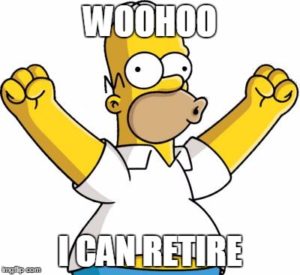In Part 2 and Part 3, we looked at how dividends provide flexibility to an investor’s cash flow needs. If you have landed here directly, you may want to start with Part 1. We also saw the high degree of customization afforded by dividend growth investing (DGI) for those who have the interest and temperament to understand how companies make money, generate dividends, and are valued. We saw how dividends are an essential part of total return even for index investors, in the latter sections of Part 3. If you have stayed with the series so far, good for you!

Don’t fret over the right investing method. Focus on ‘accumulation’ first.
In this article, basis a suggestion I received from a commenter in Part 1, we will look at which investing method (indexing or DGI) would be better for those in ‘accumulation’ phase of their lives. I don’t prefer the terms ‘accumulation’ and ‘decumulation’ that financial planners use because the boundary is not so clear in real life. You can continue to grow assets (and thus ‘accumulate’) even in retirement, especially if you live only on dividends and have a low enough withdrawal rate.
Perhaps a better term is working investors, to imply they are gainfully employed in a job or profession whose income covers all of their expenses and are able to save money – that is, new investment capital. Using this definition separates them from the early-retired folks who may take a part-time job for fun or to supplement their passive income, even as their net worth grows.
Indexing for Working Investors
I recommend an indexing strategy for working investors, for multiple reasons. This is the method I followed for nearly 15 years so I have direct experience behind my recommendation. The reasons are as follows:
- While you are a young working professional, your primary focus should be earning the highest you can and move up the career ladder. This is the time to focus on increasing job income and for developing sensibly frugal habits to maximize your savings. Every bit of spare time you have should be applied to increase your professional skills, marketability with the main objective to increase your earned income. The time you need to spend learning about DGI and executing it well could be better spent in the early years maximizing your job earnings. This is also the time to be a renter and demonstrate maximum career mobility to your employer so that better opportunities come to you.
- By doing the above, you will generate (hopefully) substantial savings every month. With that, you should be maximizing your 401(k) or similar pre-tax savings options at work. Also, open an after-tax account with Vanguard or Fidelity or any similarly large fund management company in your country that offers low cost investing options.
- Even if you don’t wish to learn anything about optimizing dividends from a taxation perspective, put your investment funds, both pre-tax and post-tax, into a low cost, diversified total market index fund. I recommend VTSMX first and if you have crossed the $10K threshold in asset size, convert into admiral shares (VTSAX) for ultra low 0.05% fees. You will be 100% invested in over 5,000 US stocks by this simple move. Then, let time and compounding work its magic for years while you focus on increasing your savings through higher income and sensible frugality.
- If you want to get a bit fancier, you could do an allocation across global equity markets (say, 70% VTSAX, 20% VGTSX and 10% VEIEX) and call it a day. This allocation is still 100% equity, so your money is working as hard for you as possible when you have time on your hands and can easily handle market volatility.
- Tax optimization. By earning the highest you possibly can, you are likely to be in higher tax brackets in any country you work. So, investing in index funds limits the dividend income your portfolio generates compared to a dividend-focused investing. This helps in reducing marginal taxes, as every dividend dollar you earn will be taxed at a higher rate if you already have sizable work earnings. Indexes are, therefore, a tax-efficient way to build wealth and provide ample diversification for a ‘buy and forget’ investor.
- There is another reason for indexing as well. There is definitely work involved in stock evaluation and selection in the DGI approach. Evaluating income statements, balance sheets, cash flow statements, financial ratios, peer landscape analysis, competitive ‘moat’ analysis and valuation techniques would not be everyone’s cup of tea. Compare the value of time spent here versus time spent in increasing job income. For those still interested and want to see their passive income truly increase every year, DGI offers a good path.
When Your Portfolio Should be Working Harder Than You
 There comes a point where an index investor faces a choice in his FIRE journey. This point usually comes when sufficient assets to ‘smell’ the FIRE (or at least equal to 5 years of living expenses, preferably more) have been accumulated. At this stage, an indexer needs to decide whether to continue on the same path or learn the principles of DGI. Eventually, you have confront the inevitable decision of having to live off of your portfolio (‘decumulation’ phase, as the financial advisers call it). At this fork-in-the-FIRE-road, an investor can choose to either:
There comes a point where an index investor faces a choice in his FIRE journey. This point usually comes when sufficient assets to ‘smell’ the FIRE (or at least equal to 5 years of living expenses, preferably more) have been accumulated. At this stage, an indexer needs to decide whether to continue on the same path or learn the principles of DGI. Eventually, you have confront the inevitable decision of having to live off of your portfolio (‘decumulation’ phase, as the financial advisers call it). At this fork-in-the-FIRE-road, an investor can choose to either:
Continue on the Indexing Highway
By doing so, you are relying on decades of academic research behind safe withdrawal rate (SWR) studies and so, there is a lot of support behind this approach. The problem, however, is a bit of a slippery slope (is 4%, 3.5%, 3.25%, 3% or even 2.5% really safe?!) because of ‘tail’ events in the back test-driven nature of such withdrawal rate simulations. There are many faces of SWR from a spending perspective. A 4% SWR vs. 3% in a $1 million portfolio, is the difference of withdrawing $40,000 vs. $30,000 – a full 33% higher in spendable income! Imagine what that could do to your retirement lifestyle. The fear of running out of money is a real beast to confront for most early retirees because their horizon is long.
I want to emphasize here there is nothing wrong with the indexing approach. In fact, this is what sound financial advisers tell you to do. But the nature of a deterministic withdrawal (in other words, start with one SWR and ratchet up every year by inflation rate) in a highly volatile equity market world disconnects you from the market and economic realities – this can be good or bad, depending on your perspective. In my view, a withdrawal method that is separated from the underlying economy gives a false feeling of income security or even a false feeling of too much fear (depending on how high or low your withdrawal rate is). While running out of money during retirement is scary, also questionable is having millions more at age 90 when neither the body nor the mind is able to benefit, especially after decades of living frugally with too small a withdrawal rate in the fear of running out of money.
Or jump onto the Dividend Parkway
In contrast, the dividend investing method gives you a direct correlation between your income and the underlying economic strength of the companies you have invested in. If they continue to be strong, you will see growing dividends. We saw in earlier posts, a 25% dividend cut on an aggregate portfolio level in S&P 500 companies is the worst in the last 50+ years. During recessions, dividend cuts have to be handled the same way you did while working for a company going through tough times. Tighten your belt! Dividend investing forces you to spend according to the business cycle and fortunes, similar to your employment years. If this gyration upsets you, then live on 90% of dividend flow and have a ‘safety’ fund for your 10% excess dividends that you don’t spend each year. You can dip into the safety fund in recessionary years to cushion the impact. Compounding and re-investing increases your safety cushion in DGI if you choose to remain fully invested. There are options in DGI to match your risk tolerance. I plan to write an article on how to estimate your own worse case scenario in DGI, stay tuned!

Fixed SWR gets sticky during long down markets.
The biggest reason why 4% SWR using index funds can fail is due to continual sale of assets for annual spending, even when the market is severely down. This is a direct outcome of a fixed SWR approach. I have examined the failure modes of various SWR studies before arriving at this conclusion, because a fixed SWR doesn’t react to changing market conditions, once chosen. There are variants of SWR method that consider market conditions, but that’s not the assurance provided by original SWR research. If you have a game plan to handle these severe bear markets (which will happen periodically), you are likely to have a great retirement. With a sound game plan, your assets will last your lifetime and perhaps even longer.
The idea of living on dividends alone is not new. This is what large charitable endowments do, and that’s why they survive long after their founders have passed on. Think Hershey Trust, Ford Foundation, Hewlett Foundation, Carnegie Foundation etc.
For example, The Hershey Trust owns over $9 billion in Hershey stock, and this year they would earn over $220 million in dividends alone! Just imagine, close to a century after the passing of Hershey’s founders, Milton and Catherine, the Milton Hershey school continues to educate over 2,000 orphans and disadvantaged kids. Moreover, since these dividends increase each year (and have been doing so for decades), they are covered practically forever. Consider Hershey’s latest dividend raise of 6% – this is more than adequate to cover inflation for a charitable institution like the Hershey Trust.
As a result, The Hershey Trust Company has been increasing their charitable spending each year without having to sell a single share of Hershey stock over the last several decades! They are the main stock the trust owns (contributing over 90% of their assets). Talk about ‘concentration risk’, right? – indexers will be shocked! The stock price of Hershey, like many others, certainly fluctuates (and can gyrate wildly during recessions, reaching a low of $30 in early 2009, to near $104 now), but the dividends flow like clockwork and increase annually. That’s why charitable institutions like The Hershey Trust stand the test of time. “Over 100 Years of Strength, Heritage, and Stability” as they proudly claim on their website. Such institutions become a valuable pillar of society.
You may not have such lofty goals for your dividend portfolio as The Hershey Trust but the larger principle still holds. Warren Buffett says his favorite holding period is forever. The Hershey Trust clearly got the memo!
If you believe DGI makes sense, you can:
Switch from the index portfolio to at least a 30-stock dividend growth portfolio, selected gradually and moved into over a few years considering valuation of each holding and general market conditions. Alternatively, you can do a direct pari passu move into the same US index allocation with a US dividend equity ETF like SCHD or VYM. There are dividend ETFs and mutual fund equivalents for international markets as well.
By doing this, you will see an immediate and significant step-up in dividend income, similar to what the better Charlie experienced in the example in Part 3. But remember, there are hardly any free rides in investing. What this does is that your future portfolio growth rate may be a bit subdued due to your current dividend focus. However, that is the ‘balance’ many passive income seekers want.
If you keep comparing with S&P 500 for returns, you may feel elated in some years (when your total return beats the index) and disappointed in other years (when it lags). Generally, a defensively-constructed DGI portfolio does well during recessions but lags the index during raging bull markets. But remember you want stable and growing passive income, that’s why you went this route in the first place.
Portfolio value is where we will take off on the next article. This is a favorite of index investors – Any stock portfolio is at risk of index lag. Stay tuned.
Raman Venkatesh is the founder of Ten Factorial Rocks. Raman is a ‘Gen X’ corporate executive in his mid 40’s. In addition to having a Ph.D. in engineering, he has worked in almost all continents of the world. Ten Factorial Rocks (TFR) was created to chronicle his journey towards retirement while sharing his views on the absurdities and pitfalls along the way. The name was taken from the mathematical function 10! (ten factorial) which is equal to 10 x 9 x 8 x 7 x 6 x 5 x 4 x 3 x 2 x 1 = 3,628,800.


4 comments on “Dividend Investing vs. Indexing – Part 4”